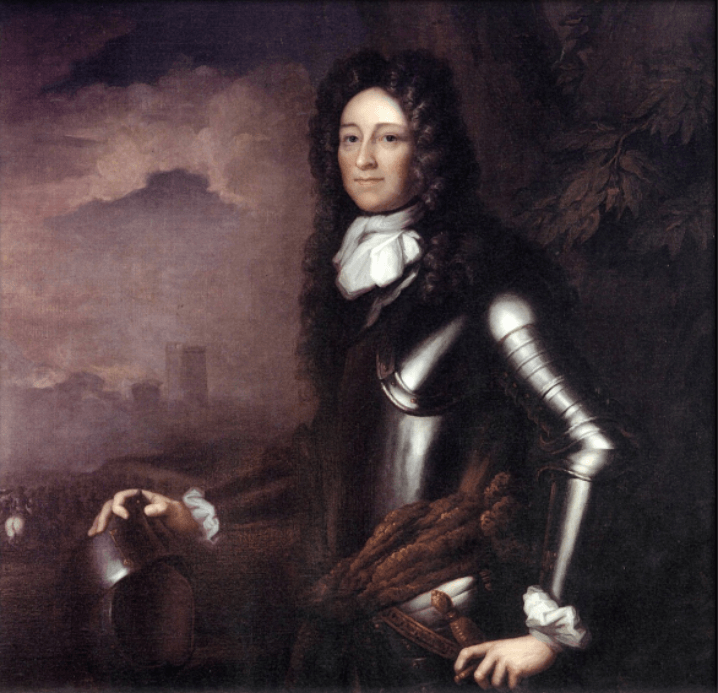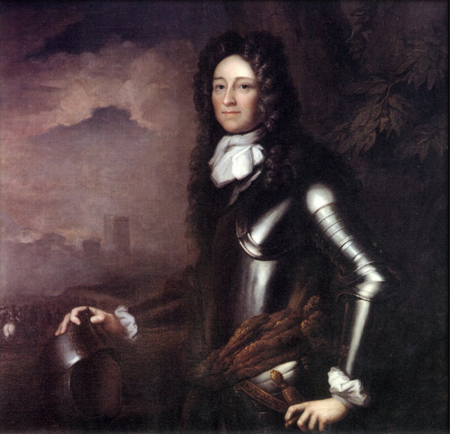Gustavus Hamilton, 1st Viscount Boyne facts for kids
Quick facts for kids
Gustavus Hamilton
|
|
|---|---|
| Viscount Boyne | |
|
Detail from the portrait below
|
|
| Tenure | 1717–1723 |
| Successor | Gustavus, 2nd Viscount Boyne |
| Born | 1642 |
| Died | 16 September 1723 |
| Spouse(s) | Elizabeth Brooke |
| Issue Detail |
Frederick, Gustavus, Henry, & others |
| Father | Frederick Hamilton |
| Mother | Sidney Vaughan |
Gustavus Hamilton, 1st Viscount Boyne (1642–1723) was an important Irish soldier and politician. When he was young, he fought for the French army in a war called the Franco-Dutch War. Later, he joined the Irish Army.
Gustavus Hamilton was a key figure in the Williamite War in Ireland. He helped defend the town of Coleraine and fought bravely in major battles like the Battle of the Boyne and the Battle of Aughrim. He was also involved in the Siege of Athlone. Because of his service, he was given a special title, becoming a Viscount, by King George I in 1715.
Contents
Early Life and Family Roots
Gustavus Hamilton was born in 1642. He was likely born at Manorhamilton Castle in County Leitrim, Ireland. His father, Frederick Hamilton, was a soldier. His mother was Sidney Vaughan.
Gustavus was the third son in his family. His grandfather was Claud Hamilton, 1st Lord Paisley from Scotland. Gustavus was named after the famous Swedish king, Gustavus Adolphus of Sweden. His father had fought alongside this king during the Thirty Years' War in Germany.
Gustavus's mother, Sidney Vaughan, was the only child of Sir John Vaughan. Sir John had been the governor of Derry. Her family came from Wales.
Becoming a Soldier
Gustavus's father died in 1647 when Gustavus was only about five years old. In 1661, Gustavus started studying at Trinity College Dublin. However, he left before finishing his degree.
In 1672, he went to France. There, he became a captain in a military group led by his cousin, Sir George Hamilton, Comte Hamilton. This group fought for King Louis XIV of France against the Holy Roman Empire. They were part of the Franco-Dutch War (1672–1678). Gustavus fought in several battles, including Sinsheim and Entzheim in 1674, and Turckheim, Sasbach, and Altenheim in 1675.
When his cousin Sir George was killed in 1676, Gustavus left the French army and returned to Ireland.
Marriage and Children
Gustavus Hamilton got married before 1686 to Elizabeth Brooke. She was the daughter of Sir Henry Brooke, a knight from Brookeborough, County Fermanagh.
Gustavus and Elizabeth had three sons and one daughter:
- Frederick (died 1715): He passed away before his father. However, Frederick's son later became the 2nd Viscount Boyne.
- Gustavus (died 1734): He was a politician and a Member of Parliament (MP) for County Donegal.
- Henry (1692–1743): He also became an MP for County Donegal.
- Elizabeth: She married Charles Lambart.
Before the War in Ireland
In 1677, Gustavus Hamilton traveled to Oxford. There, he received a special degree called a Doctor of Civil Law from the University of Oxford. By 1678, he was a captain in the Irish Army.
When King James II of England became king in 1685, he appointed Hamilton to the Privy Council of Ireland. This was a group of important advisors to the king.
In 1688, Hamilton was a major in a military group in Derry. The leader, Tyrconnell, ordered the group to move to Dublin. Mountjoy then made Robert Lundy the governor of Derry.
Fighting in the Williamite War
When the Glorious Revolution happened, Gustavus Hamilton decided to support William of Orange.
In 1689, Richard Hamilton attacked Protestants in northern Ireland. Gustavus Hamilton helped organize the defense of Coleraine. His forces held out for five weeks before they had to retreat to Derry.
King James called a parliament in 1689, known as the Patriot Parliament. This parliament listed Gustavus Hamilton as someone who had committed a serious crime against the king.
On July 1, 1690, Gustavus Hamilton led a group of soldiers at the famous Battle of the Boyne. His horse was shot from under him, and he almost died.
In June 1691, he fought at the Siege of Athlone. On June 30, Hamilton was part of a brave attack. His soldiers crossed the River Shannon to capture the town. He led the cavalry (soldiers on horseback) in this attack.
In July, he also fought in the Battle of Aughrim. His group was in the front line, in a central position.
Important Roles and Titles
In 1691, Gustavus Hamilton was given an honorary title: Vice-Admiral of Ulster. This meant he was a high-ranking official related to the navy in the Ulster region. He held this position until 1710, when he passed it to his son Frederick. After Frederick died in 1715, Gustavus became Vice-Admiral of Ulster again until his own death in 1723.
Serving as an Irish Member of Parliament
Gustavus Hamilton served as a Member of Parliament (MP) in Ireland for many years.
- In 1692, he was elected as one of the two MPs for County Donegal.
- He was re-elected for County Donegal in 1695.
- He was elected again for County Donegal in 1703.
- In 1713, he was elected as an MP for Strabane.
Later Life and Honors
Gustavus Hamilton continued to rise in the military. He was promoted to brigadier-general in 1696 and major-general in 1704. In 1706, he left his military group.
In May 1710, Queen Anne appointed him to the Privy Council of Ireland again.
Around 1715, he bought land near Slane in County Meath and built a house called Stackallan House.
When George I became king in 1714, Hamilton remained on the Irish privy council. In 1715, King George I gave him a special noble title, making him Baron Hamilton of Stackallan. Then, on August 20, 1717, the king honored him even more by making him Viscount Boyne. In 1719, he took part in the Capture of Vigo, a military operation.
His wife, Elizabeth, passed away in 1721.
Death and Successor
Lord Boyne died on September 16, 1723. He was buried in the church at Stackallan.
Since his oldest son, Frederick, had died before him, Gustavus was succeeded by his grandson, Gustavus, who became the 2nd Viscount Boyne.
| Timeline of Gustavus Hamilton's Life | ||
|---|---|---|
| Age | Date | Event |
| 0 | 1642 | Born in Ireland. |
| 5 | 1647 | His father died. |
| 19 | 1661, 17 April | Started studying at Trinity College, Dublin. |
| 30 | 1672 | Went to France and became a captain in his cousin's army group. |
| 34 | 1676 | Returned to Ireland. |
| 35 | 1677 | Received a special degree from the University of Oxford. |
| 43 | 1685 | Became an Irish privy councillor under King James II. |
| 47 | 1689 | Defended Coleraine during the war. |
| 47 | 1689 | Was listed as an enemy by the Patriot Parliament. |
| 48 | 1690, 1 July | Fought at the Battle of the Boyne. |
| 49 | 1691, 30 June | Helped capture Athlone by crossing the river during the Siege of Athlone. |
| 50 | 1692, February | His youngest son, Henry, was born. |
| 50 | 1692, 22 September | Elected as an MP for County Donegal. |
| 54 | 1696, 30 May | Promoted to brigadier-general. |
| 64 | 1706, 1 May | Left command of his army group. |
| 65 | 1707, 1 September | His oldest son, Frederick, got married. |
| 68 | 1710, May | Became an Irish privy councillor again under Queen Anne. |
| 71 | 1713, 25 November | Elected as an MP for Strabane. |
| 73 | 1715, 20 October | Given the title Baron Hamilton of Stackallan. |
| 73 | 1715, 10 December | His oldest son, Frederick, died. |
| 75 | 1717, 20 August | Given the higher title of Viscount Boyne. |
| 79 | 1721, 28 December | His wife, Elizabeth Brooke, died. |
| 81 | 1723, 16 September | Died and was buried at Stackallan. |
See also
- List of parliaments of Ireland



